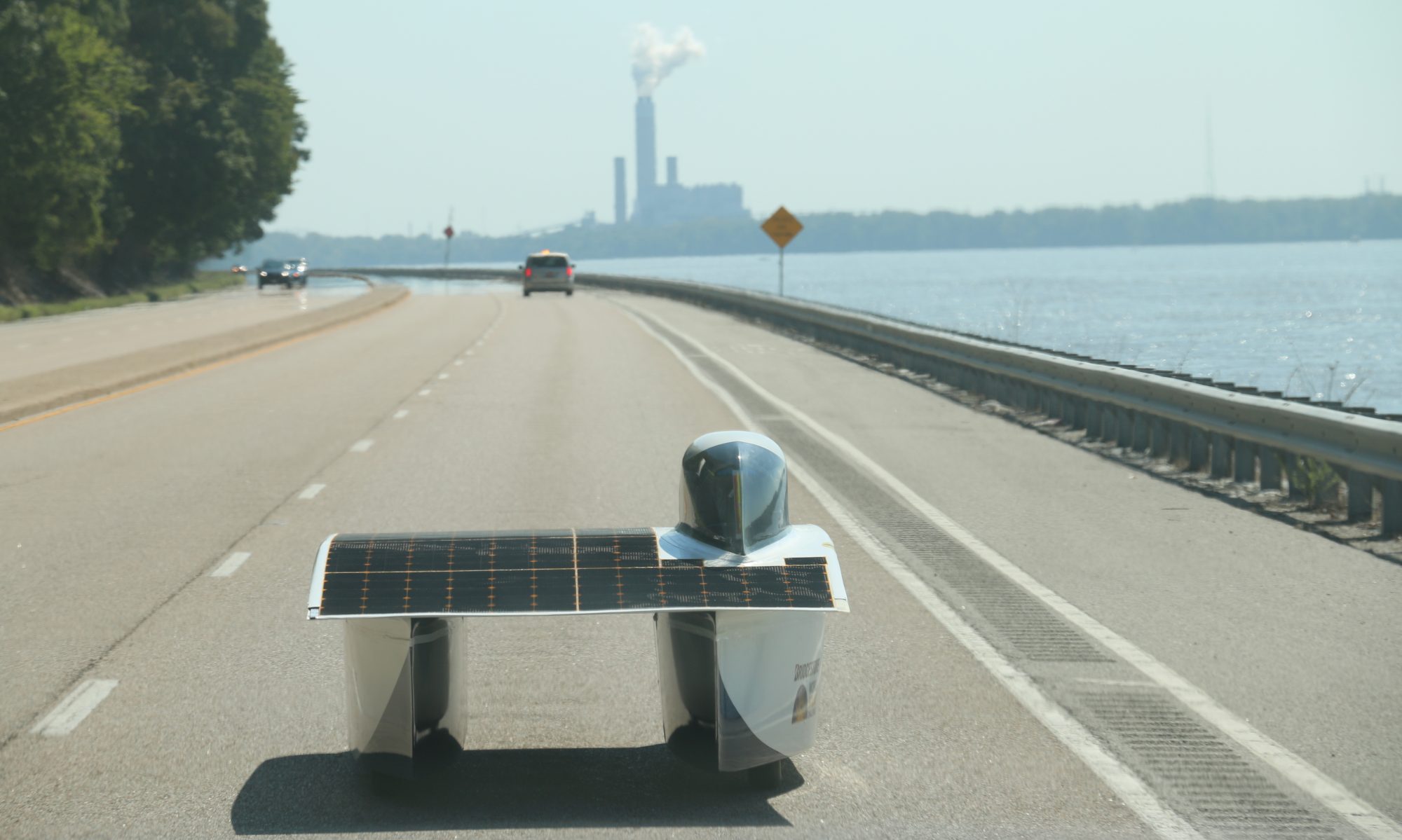Principia is by far the smallest college in the American Solar Challenge. That comes as no surprise to those who have followed RA One, Two, Three, up through Ten, around the country and around the world—including Australia, Greece, and China. China was my first experience with RA and the Principia solar car team. This summer we’re commemorating the 200th anniversary of the Santa Fe Trail, by racing from its start in Independence, Missouri, to its terminus in Santa Fe, New Mexico.
Larry Short, president of the Santa Fe Trail Association (who was sitting across from RA XI in the display area in Independence), pointed out to me that the Association and the National Park Service are not “celebrating” the 200th anniversary of the Trail but “commemorating” it. He explained that the impacts of the great trails—Santa Fe, Oregon, and California—on the Native American peoples should not be celebrated but understood and commemorated. On the hills east of McPherson, Kansas (end point of the first day of the race), are silhouettes of three Native American warriors on horseback to remind us of these First Peoples.
Like the wagon caravans of two centuries ago, the solar car teams travel with their necessary provisions—peanut butter and jelly sandwiches, and lots of spare parts and tools. And they’re always armed with the GPS coordinates to the nearest Home Depot or auto supply store. Each caravan is led by a scout car, usually an hour ahead of the team. The organizers have provided detailed instructions, listing every stop sign and turn, as well as every apparent hazard. The scouts are looking for the most recent changes along “the trail.”
The Principia team is connected by group text, with over several hundred messages flying across phones in a day. Multiple threads and conversations, from road hazards to wobbly tires to instructions to pass another caravan zip back and forth between team members. East of McPherson was “an alligator,” the shredded tire of a tractor trailer rig. Our truck and trailer team stopped and removed the hazard.
The immediate caravan always has a lead car or van. Then comes the solar car itself, followed closely by the chase car or van. The purpose of the chase vehicle is to protect the solar car. Its goal is to prevent any other vehicle from slipping in behind the very vulnerable solar car. To a massive truck, the tiny flat car below them, covered with black or greyish solar cells, looks like pavement. Based on my experience driving around America, I recommend recruiting chase car drivers from Boston.
Somewhere ahead, behind, or on a parallel route are the support vehicles, primarily the truck and trailer, carrying extra tools and supplies.
The teams are connected by cellphones, short range radios, and CB radio. It was only by happenstance that we were on CB channel 32, the historic number for the Principia solar car (and so acknowledged by the race staff). Every car has a GPS tracker device by which anyone can track the progress of our car via the race website. But . . .
It’s nice to be mistaken for MIT! Or at least, it appears that RA XI has MIT’s tracker assigned to our car. So, it looks like we’re in first place or very close.
Wait! We are in first place or very close!
At the end of the first day of racing, “the last shall be first” (or very close). That’s right, RA XI started the race in last place.
On Sunday, July 25, Missy and I drove down to the workshops behind the Facilities Department on the College campus to wave RA XI and the team off to scrutineering. I made a mental note to ask our webmaster to share photos of “the car” that afternoon. Think of dismantling your great uncle’s grandfather clock, shaking up the parts in a box, and spilling them across the floor. You might recognize some of the parts, but it doesn’t resemble a clock.
Yet, less than a day later and over three hundred miles to the west, RA XI was all put together. The clock was assembled and functional.
To push the metaphor a step further—unfortunately, the clock didn’t meet Swiss standards. Scrutineering is the process by which “the scrutineers” check the standards—for operations, construction, safety, etc. Unless you pass these rigors, your car is not allowed on the track to test for handling and endurance. And without passing handling and endurance, you’re not permitted on the road.
RA XI didn’t pass scrutineering for several days—not until Saturday evening. Only one day was left to pass the road tests. Yikes! But whew, we made it and were the last car to pass scrutineering and log the minimum 205 miles of endurance and handling (thanks to the Brookes brothers—Principia drivers, not tailors).
So, on Tuesday (8/3) morning, sitting in last place was the humble RA XI. Somewhere up the line are Illinois State, University of Illinois, University of California-Berkeley, and MIT. Ken Pratt, Principia dad and veteran team volunteer turned to me in the shadow of the Jackson County Courthouse and said, “The first shall be last.” He was referring to Principia’s habit of being the first car on location. It does help get media attention when you are the only car available for interviews (but Principia College senior Chris Strong would describe his role as team media spokesperson). Then Ken added, “. . . and the last shall be first.”
Being the last to pass scrutineering, RA XI was assigned the last position to leave Independence. You can guess the punch line. Two hundred twenty-two miles and more than six hours later, RA XI arrived first in McPherson, Kansas, swapping leads with MIT. The GPS was really confused.
The solar car race is not just technology. It’s also about strategy. At McPherson, teams could add additional miles to their total, perhaps compensating for penalty deductions. The downside might be risking unnecessary wear and tear or damage to the car or reducing time to recharge the batteries. MIT announced, at McPherson, that they would take the option to run a 22-mile loop (crossing six sets of railroad tracks—ouch—and a length of interstate—stress!).
Principia’s team decided to hold back and take time to recharge the battery and check the car, while not risking unnecessary stress on the car. Ah, but then the team decided to make the loop. Being first to arrive, Principia left first. MIT followed. Then another school decided to add extra miles.
Another challenge with adding miles is that the timing is limited. The cars need to be back on the lot within set times.
Ah-ha! Principia returned on time and in good form! The multiple railroad track crossings were easily navigated. The interstate traffic was manageable and not too intense. RA XI can handle 50 mph in the right lane, with the chase car fending off trucks.
The three-vehicle caravan returned to cheers from several Principia alums and families. Required to sit for 15 minutes, the team was able to calculate that it could do a second loop within deadline. They’re off—aiming for a total of 44 extra miles!
MIT—after raising the original challenge—gulps, sits out their 15 minutes, and heads off for another loop. They make it back, with minutes to spare. If they hadn’t, they would have lost that second set of 22 miles. So, who is in first place?
As I type this, we don’t know. In the meantime, the MIT team is writing a cheer for RA XI! The Solar Car Challenge is as collegial as it is competitive. It is a pleasure to watch young people gather to seriously consider the costs and benefits of taking risks. The decision is made. They notify the race officials and dash for their vehicles. The car and driver must undergo the last-minute safety inspection, and the countdown clock is set. The three vehicles line up—lead, car, chase. The signal is given, and the vehicles pull into traffic.
Back on the lot, other teams might be struggling with overheated batteries or weak solar cells.
I promised you a couple of tips.
It is possible for batteries to overcharge. This was true in the early days of solar car racing. You could be racing along on a bright sunny day and realize that the solar cells were sucking in more energy than you were using. The battery load indicator was an important instrument because the battery could explode. What do you do?
You need something to drain the battery quickly. You can’t just pull over and dump out the battery. This was explained to me during the solar car race in China. Me—all common sense and no technical sense—thought about the fastest energy draining device I could remember— my wife’s electric hairdryer.
The Principia students looked at me and exclaimed, “Don’t you remember the car from California in the last race with the two exhaust pipes? Hair dryers! They hung a pair of hair dryers on the car with a switch to turn them on. Problem solved.”
I wonder what the pit conversation was— “Sunbeam or Norelco?”
However, batteries have improved and so have solar cells. This means you need to be careful in cleaning your solar cells. You need distilled water in large pump canisters, carefully sprayed and gingerly wiped. You must be careful to check your ingredients. Not all distilled water is distilled without chemicals, containing nothing that leaves a residue on your cells.
Tomorrow, I’ll share this space with my wife, Missy. She was touched by the reception that the citizens of Council Grove, Kansas, gave to the teams and cars.



Thanks for writing this John. The most impressive aspect of the Prin team to me is their hard-nosed use of Christian Science for healing, for direction, for emergency repairs, etc. etc. Everyone involved has an inspiring testimonial to tell of answered prayer for every conceivable problem you could run into during a road race. I’ve got one I’ll tell you some time.